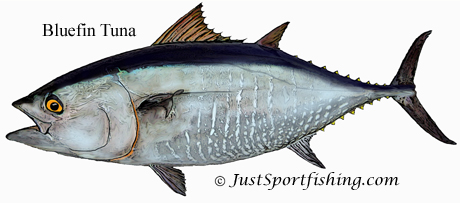|
Home Game Fish Fishing Knots Tackle Tips Videos Pictures Tips Rods & Reels Boats Cook your Catch Articles About Contact |
|
Donate to JustSportfishing.com and help to build the largest fishing information site on the web. Even a dollar or two will keep us building this free site. |
Bluefin
Tuna World
Record
~ 1496 Lbs at Aulds Cove, Nova Scotia on Oct. 26, 1979 by angler Ken
Fraser Scientific
name
~ Thunnus Thynnus Other
names
~ Bluefin Tuna, Atlantic Bluefin Tuna, Blue Fin Tuna, Bluefin Tunny,
Blue-fin tunny, Northern Bluefin Tuna Identification
~ The body is a metallic
deep blue above and the lower sides and belly are silvery white. When
first caught, alternating colorless lines and rows of dots can be seen
along the lower sides. The first dorsal fin is yellow or blue, the
second is red or brown. The anal fin and finlets are yellow, edged with
black. The central caudal keel is black. The bluefin tuna is one of the
largest of the tunas. The body is deepest near the insertion of the
pelvic fins, and tapers significantly to the caudal peduncle. Compared
to other tunas, the head is long and somewhat pointed, and the eye is
small. Two dorsal fins are present, with a small space separating them. Size
~ The maximum length
reported is 180 inches total length. Angler caught Bluefin from 16
inches to 80 inches are common. Adult Bluefin range in weight from 300
pounds to 1500 pounds, but fish over a 1,000 pounds are rare. Bluefin
commonly attain a size of 78 inches. It is believed that bluefin tuna
has a life span of approximately 15 years. Habitat
~ This tuna is epipelagic and oceanic, coming near shore seasonally. It
can tolerate a considerable range of temperatures and has been observed
both above and below the thermocline, down to depths of greater than
3000 feet (9,850 m). Bluefin
tuna exhibit strong schooling behavior while they are young. While
schooling is believed to be sight oriented, schools have been observed
at night. Therefore, other senses (particularly the lateral line) appear
to be involved in this behavior. Schools of bluefin seasonally migrate
northward during the summer months along the coast of Japan and the
Pacific coast of North America. The bluefin tuna is distributed
throughout the Atlantic and Pacific Oceans in subtropical
and temperate waters. In the western Atlantic Ocean, it is found from
Labrador, Canada, to northern Brazil, including the Gulf of Mexico. In
the eastern Atlantic Ocean, it is found from Norway to the Canary
Islands. In the western Pacific Ocean, it is distributed from Japan to
the Philippines. In the eastern Pacific Ocean, it is distributed from
the southern coast of Alaska, USA to Baja California, Mexico Feeding
Habits
~ Bluefin feed on squid, eels, crustaceans, and pelagic schooling fish
such as mackerel, flying fish, herring, whiting, and mullet.
|


